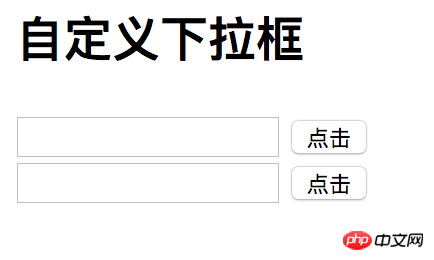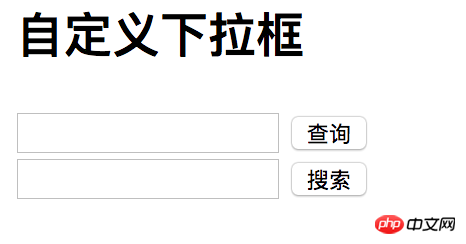 Web Front-end
Web Front-end
 JS Tutorial
JS Tutorial
 How to implement component and parent-child component communication in Vue2.0
How to implement component and parent-child component communication in Vue2.0
How to implement component and parent-child component communication in Vue2.0
This article mainly introduces the detailed explanation of Vue components and parent-child component communication in Vue2.0 learning. The editor thinks it is quite good, so I will share it with you now and give it as a reference. Let’s follow the editor and take a look.
What are components?
The components in vue are actually part of the page, such as every component in the computer (such as hard disk, keyboard, mouse). It has independent logic or interface, and at the same time can be based on The specified interface rules are integrated with each other to become a complete application.
The page is composed of parts like this, such as navigation, lists, pop-up windows, drop-down lists, etc. The page is just a container for these components. The components are freely combined to form a fully functional interface. When a component is not needed or you want to replace it, you can replace and delete it at any time without affecting the operation of the entire application.
The core idea of front-end componentization is to split a huge and complex thing into small things with reasonable granularity.
What are the benefits of using components?
1. Improve development efficiency
2. Convenient for reuse
3. Simplify debugging steps
4. Improve the maintainability of the entire project
5. Facilitate collaborative development
Component in vue
The component in vue is a custom tag, and the compiler of vue.js adds special functions to it
Component in vue You can also extend native html elements to encapsulate reusable code
Basic components of components: style structure, behavior logic, data
Registered components
Global registration
Can be used in any template, you must register before use
Syntax: use Vue.component(component name, option object)
Component name naming convention: camel case, kebab
Use components in html: use kebab naming method
For example, register Vue.compontent('my-compontent',{}) ,When using
<p id="app">
<h2>自定义下拉框</h2>
<cus-list></cus-list>
<cus-list></cus-list>
</p>
<script type="text/javascript" src='https://i0.jrjimg.cn/zqt-red-1000/focus/focus2017YMZ/teamFrighting/js/vue.min.js'></script>
<script type="text/javascript">
// 全局注册组件
Vue.component('cus-list',{
data(){
return {
}
},
template:`
<section>
<p>
<p>
<input type="text">
<input type="button" name="" value="">
<span></span>
</p>
</p>
</section>
`
})
new Vue({
el:"#app",
data:{
}
})
</script>When using, you only need to call this component on the page to use it and it can be reused.

Component.png
Local registration
Registered through the option object in the component instance, only in the Components registered locally using
<p id="app">
<h2>自定义下拉框</h2>
<cus-list></cus-list>
<cus-list></cus-list>
</p>
<script type="text/javascript" src='https://i0.jrjimg.cn/zqt-red-1000/focus/focus2017YMZ/teamFrighting/js/vue.min.js'></script>
<script>
new Vue({
el:"#app",
components:{
'cus-list':{
template:`
<section>
<p>
<p>
<input type="text">
<input type="button" name="" value="">
<span></span>
</p>
</p>
</section>
`
}
},
data:{
}
})
</script>in the registered scope can only be used in the scope of the current instance, and can also be reused in the scope. The effect is as follows.

Component.png
Communication between parent and child components
Communication between parent component and child component
Parent component===》Child component (using props)
The scope of the component instance is isolated, and the child component cannot directly use the data of the parent component.
You can use custom properties to bind data on the component, and use props to customize the property name to be displayed in the component.
That is to say, remember one sentence. When a parent component passes a value to a child component, it is to add an attribute to the component when calling the component, and then use props to receive it in the component. It can be used according to the attribute name in the component. .
<p id="app">
<h2>自定义下拉框</h2>
<cus-list btn-value="查询"></cus-list>
<cus-list btn-value="搜索"></cus-list>
</p>
<script type="text/javascript" src='https://i0.jrjimg.cn/zqt-red-1000/focus/focus2017YMZ/teamFrighting/js/vue.min.js'></script>
<script>
Vue.component('cus-list',{
data(){
},
props:['btnValue'],
template:`
<section>
<p>
<p>
<input type="text">
<input type="button" name="" :value="btnValue">
<span></span>
</p>
</p>
</section>
`
})
new Vue({
el:"#app",
data:{
}
})
</script>Page effect

props pass value.png
The child component communicates with the parent component
Sub component===》Parent component
You need to use custom time. The parent component uses $on to listen to custom events, and $emit triggers the customization that the parent component cares about. event.
1. Define the event content in the sub-component
2. v-on custom events in the parent component are received v-on:receive="changeValue"
3. When the child component event is triggered, $emit notifies the parent component of this.$ emit("receive",item);
4. The parent component provides corresponding feedback according to the custom event changeValue:function(value){this.val = value;}
Look at the following case, When you click input, a drop-down list box appears, select the corresponding list, and the list content appears in the input box.
<p id="app">
<h2>自定义下拉框</h2>
<cus-list select-Value="搜索" v-bind:list="list1" >
</cus-list>
</p>
<script type="text/javascript" src='https://i0.jrjimg.cn/zqt-red-1000/focus/focus2017YMZ/teamFrighting/js/vue.min.js'></script>
<script type="text/javascript">
// 全局注册组件
Vue.component('cus-list',{
data(){
return {
selectShow:false,
val:''
}
},
props:['selectValue','list'],
template:`
<section>
<p>
<p>
<input type="text" @click="selectShow = !selectShow" :value="val">
<input type="button" name="" :value="selectValue">
</p>
<list-li :list="list" v-show="selectShow" v-on:receive="changeValue"></list-li>
</p>
</section>
`,
methods:{
changeValue:function(value){
this.val = value;
}
}
})
Vue.component('list-li',{
props:['list'],
template:`
<ul>
<li v-for="item of list" @click="clickLi(item)">{{item}}</li>
</ul>
`,
methods:{
clickLi:function(item){
this.$emit("receive",item);
}
}
})
new Vue({
el:"#app",
data:{
list1:['宋仲基','余文乐','鹿晗','陈小春','黄晓明','易烊千玺']
}
})
</script>The above is what I compiled for everyone. I hope it will be helpful to everyone in the future.
Related articles:
How to solve the conflict between Django and Vue syntax
How to crawl website images in nodejs
About ES6/JavaScript usage skills (detailed tutorial)
How to dynamically set placeholder prompt text using WeChat applet
The above is the detailed content of How to implement component and parent-child component communication in Vue2.0. For more information, please follow other related articles on the PHP Chinese website!

Hot AI Tools

Undresser.AI Undress
AI-powered app for creating realistic nude photos

AI Clothes Remover
Online AI tool for removing clothes from photos.

Undress AI Tool
Undress images for free

Clothoff.io
AI clothes remover

Video Face Swap
Swap faces in any video effortlessly with our completely free AI face swap tool!

Hot Article

Hot Tools

Notepad++7.3.1
Easy-to-use and free code editor

SublimeText3 Chinese version
Chinese version, very easy to use

Zend Studio 13.0.1
Powerful PHP integrated development environment

Dreamweaver CS6
Visual web development tools

SublimeText3 Mac version
God-level code editing software (SublimeText3)

Hot Topics
 What should I do if I encounter garbled code printing for front-end thermal paper receipts?
Apr 04, 2025 pm 02:42 PM
What should I do if I encounter garbled code printing for front-end thermal paper receipts?
Apr 04, 2025 pm 02:42 PM
Frequently Asked Questions and Solutions for Front-end Thermal Paper Ticket Printing In Front-end Development, Ticket Printing is a common requirement. However, many developers are implementing...
 Demystifying JavaScript: What It Does and Why It Matters
Apr 09, 2025 am 12:07 AM
Demystifying JavaScript: What It Does and Why It Matters
Apr 09, 2025 am 12:07 AM
JavaScript is the cornerstone of modern web development, and its main functions include event-driven programming, dynamic content generation and asynchronous programming. 1) Event-driven programming allows web pages to change dynamically according to user operations. 2) Dynamic content generation allows page content to be adjusted according to conditions. 3) Asynchronous programming ensures that the user interface is not blocked. JavaScript is widely used in web interaction, single-page application and server-side development, greatly improving the flexibility of user experience and cross-platform development.
 Who gets paid more Python or JavaScript?
Apr 04, 2025 am 12:09 AM
Who gets paid more Python or JavaScript?
Apr 04, 2025 am 12:09 AM
There is no absolute salary for Python and JavaScript developers, depending on skills and industry needs. 1. Python may be paid more in data science and machine learning. 2. JavaScript has great demand in front-end and full-stack development, and its salary is also considerable. 3. Influencing factors include experience, geographical location, company size and specific skills.
 How to merge array elements with the same ID into one object using JavaScript?
Apr 04, 2025 pm 05:09 PM
How to merge array elements with the same ID into one object using JavaScript?
Apr 04, 2025 pm 05:09 PM
How to merge array elements with the same ID into one object in JavaScript? When processing data, we often encounter the need to have the same ID...
 Is JavaScript hard to learn?
Apr 03, 2025 am 12:20 AM
Is JavaScript hard to learn?
Apr 03, 2025 am 12:20 AM
Learning JavaScript is not difficult, but it is challenging. 1) Understand basic concepts such as variables, data types, functions, etc. 2) Master asynchronous programming and implement it through event loops. 3) Use DOM operations and Promise to handle asynchronous requests. 4) Avoid common mistakes and use debugging techniques. 5) Optimize performance and follow best practices.
 How to achieve parallax scrolling and element animation effects, like Shiseido's official website?
or:
How can we achieve the animation effect accompanied by page scrolling like Shiseido's official website?
Apr 04, 2025 pm 05:36 PM
How to achieve parallax scrolling and element animation effects, like Shiseido's official website?
or:
How can we achieve the animation effect accompanied by page scrolling like Shiseido's official website?
Apr 04, 2025 pm 05:36 PM
Discussion on the realization of parallax scrolling and element animation effects in this article will explore how to achieve similar to Shiseido official website (https://www.shiseido.co.jp/sb/wonderland/)...
 The difference in console.log output result: Why are the two calls different?
Apr 04, 2025 pm 05:12 PM
The difference in console.log output result: Why are the two calls different?
Apr 04, 2025 pm 05:12 PM
In-depth discussion of the root causes of the difference in console.log output. This article will analyze the differences in the output results of console.log function in a piece of code and explain the reasons behind it. �...
 How to implement panel drag and drop adjustment function similar to VSCode in front-end development?
Apr 04, 2025 pm 02:06 PM
How to implement panel drag and drop adjustment function similar to VSCode in front-end development?
Apr 04, 2025 pm 02:06 PM
Explore the implementation of panel drag and drop adjustment function similar to VSCode in the front-end. In front-end development, how to implement VSCode similar to VSCode...





